ART CULT HIST group project PDF

| Title | ART CULT HIST group project |
|---|---|
| Course | Intro IS: Art Cult Hist |
| Institution | University of Winnipeg |
| Pages | 12 |
| File Size | 431.8 KB |
| File Type | |
| Total Downloads | 46 |
| Total Views | 139 |
Summary
ESSAY...
Description
Running head: INDIGENOUS WOMEN ARTISTS THROUGH TIME AND SPACE
Indigenous Women Artists Through Time and Space
University of Winnipeg IS Art Culture and History 1016 - 004 Eduardo Vergolino
1
INDIGENOUS WOMEN ARTISTS THROUGH TIME AND SPACE
2
The theme chosen is Female Indigenous Artists. This was decided upon because throughout First Nations history, women played a vital role in civilization. As a group, women were praised for their bead work, paintings, tanning of animal skin, providing and caring for the children while men were off hunting - this is just to name a few. As a group, we wanted to keep honouring Indigenous women, and to give praise to the art they have shared. We wanted to celebrate women artists for their creativity, and to show respect for sharing a piece of their own culture with us. The following artists are not from one specific area; they are located all around North America. They vary in age, each with different views of their own culture, as well as mediums and diversity. They complement each other by giving a piece of culture and history, which in the end, creates a beautiful story for the world to observe and learn. One way they challenge each other is how the following artists were taught. Traditionally, the younger generation is suppose to be taught by family. Though, looking back at history, some of the traditions became diluted and forgotten. A few of the artists had to learn from schools, elders in the community and some did learn from family. As a group, we would not say they challenge each other, instead they work together to finish a puzzle that was started years ago.
INDIGENOUS WOMEN ARTISTS THROUGH TIME AND SPACE
3
This seed jar was made circa 1150 C.E., using fired clay and pigment, by an unknown Ancestral Puebloan artist. Ancestral Puebloan pottery has traditionally been a women’s art, developed through centuries of experimentation. By 900 C.E., decorated pottery was a distinct characteristic of Ancestral Pueblo peoples. Women made finely crafted objects while taking into consideration the aesthetic, practical, and ecological sides. The seed jar above was created during the ancient era of Ancestral Puebloan pottery, from 1000 – 1250 C.E. The potter who made this seed jar used a technique of negative painting, in which she used black pigment to fill in negative space, creating an illusion of white designs on a black background. Jars such as this were used to store seeds for planting, and the artist likely incorporated motifs of the agricultural cycle such as seeds or kernels of corn represented by the small, consecutive squares. This piece was chosen for the show and fits into the theme of women because pottery in Indigenous North America is one of the oldest women’s arts. In Ancestral Puebloan communities as well as other ancient Indigenous communities, women’s arts were highly respected. This seed jar is a very early example, showing us just how far back women’s influence has reached, and showing us how connected women were to the community. It also sparks a deeper train of thought on how we see Indigenous women’s art today, and makes us consider that a traditional woman-made piece like this was not (and still might not be today) respected as an art piece because of the gender of the artist who made it.
INDIGENOUS WOMEN ARTISTS THROUGH TIME AND SPACE
4
‘Big One and the Bad Medicine Woman’ is an outstanding drawing made by the famous artist, Daphne Odjig. Born in 1919, and raised in the village of Wikwemikong, on Manitoulin Island, Daphne Odjig, an Ojibway artist, was the first indigenous woman artist to have her work recognized in the 1960s. In 1973, she co-founded the Professional Native Indian Artists Association (colloquially called the "Indian Group of Seven”), where she stood as the first and only woman in the group. After receiving countless achievements, such as the Governor General’s Award for Visual Arts in 2007, she passed away in 2016, at the age of 97. Ultimately, Odjig’s works are still being looked upon as some of the most stunning indigenous artworks across Canada, with works such as “Big one and the Bad Medicine Woman”, made in 1974, which draws on themes such as mythology and shamanism, but gives particular focus to women, and their roles as givers of life. To create such a captivating masterpiece, Odjig used materials such as acrylic paint over graphite on heavy ivory wove paper. This intriguing piece of artwork I chose is relevant to the theme of “woman” because Odjig is portraying the male perspective about the control of male power through their genitals. Odjig defies that perspective by illustrating the power a woman can have over a man with just her body. For example, the genitals of the bad medicine woman are lined with teeth capable of depriving unfaithful men of their “power”. Odjig presented a piece about feminism in a time in history where feminism was barely a recognizable term. She’s an influential female artist, drawing about the empowerment of women, and breaking the stereotypes held over them. Daphne Odjig is an inspiration to women across the globe, including myself.
INDIGENOUS WOMEN ARTISTS THROUGH TIME AND SPACE
5
Rebecca Belmore is a First Nations female artist, who was born on March 22, 1960, in Upsala, Ontario (Mira B. Rebecca Belmore) . She was surrounded by her big family, which is from the Anishinabe tribe. Ms. Belmore dropped out of middle school and began to work. She then returned to finish her high school degree a few years later in Thunder Bay. Once she came back, a teacher took an interest in her art work. That instructure encouraged Rebecca Belmore to submit her art work locally. This is where her art path began. From there, she pursued a degree in Experimental Arts at the Ontario College of Art from 1984 – 1987(Mira B. Rebecca Belmore) . One of her main attraction pieces is called the Trace, a blanket created solely from ceramic beads (Human Rights Museum, 2014, Rebecca Belmore's Trace). It is currently hanging in the Winnipeg Human Rights Museum. The blanket hangs about thirty feet tall, and twenty feet wide. It contains approximately ten thousand ceramic clay beads. The clay that was used had been gathered from many different Winnipeggers from the Red River, in various parts; the clay used is called gumbo clay. There was an article released to the public in Winnipeg from Ms. Belmore, asking locals to help her mold beads. Each bead is created by individuals that live here in Winnipeg and consider it their home (Human Rights Museum, 2014, Rebecca Belmore's Trace). This art piece was not only created by her, but also by the people. This piece relates to the theme of women and it shows how Rebecca Belmore, a female artist, has been taught from various artists within her culture and environment. Her art relates to political issues regarding Indigenous people and sometimes what they have lost in their traditions. For example, the Trace is an acknowledgement towards the many different generations who have passed and who will come. This art piece is an acknowledgement of Aboriginal history, and it is a symbolic piece of hope for all to see, hope for the future, as well as
INDIGENOUS WOMEN ARTISTS THROUGH TIME AND SPACE
6
appreciation for the past (Human Rights Museum, 2014, Rebecca Belmore's Trace). Though it is a reminder that we all are from the same place; that is why she used clay from the Red River and not from the store. This shows we are all given the same place as well and that there is always hope for what the future may bring.
INDIGENOUS WOMEN ARTISTS THROUGH TIME AND SPACE
7
Banchi Hanuse is an emerging Nuxalk filmmaker and UBC First Nation Studies Program alumna from Bella Coola, British Columbia. She wrote, produced, and directed her first short film called Cry Rock, which premiered at the National Geographic’s All Roads Film Festival in 2010. As an incredibly powerful documentary, it has received great praise and many awards, including Golden Sheaf’s “Best Documentary Short” award. Cry Rock has since been featured in numerous film festivals and is still showcased at major festivals throughout North America. Hanuse documents her 80-year-old grandmother in Cry Rock, as her grandmother is one of the last remaining speakers of the Nuxalk language. Less than 15 people speak the Nuxalk language, and as each person passes away, so does the language and their stories. The Nuxalk nation has a small population of about 1550 people. (Indigenous and Northern Affairs Canada, 2013.) In Cry Rock, Hanuse struggles with the decision to whether or not record her grandmother telling Nuxalk stories. Seen as the easy way out, Hanuse refuses to record her grandmother and instead directs her focus to the necessity to understand and learn the true meaning of each of her nation’s stories. By doing this, she encourages others to put effort into learning the dying language in order to immerse them in true understanding to their culture. In the documentary, the story of the “Cry Rock” found in the Atnarko River in the Bella Coola Valley is retold by a Nuxalk man named Clyde Tallio. The interview like fashion of the documentary is accompanied by impressive watercolour paintings and animations of the Bella Coola Valley to enhance the viewer’s storytelling experience. Cry Rock effectively showcases the importance of preserving the identity and culture of people, especially the diminishing Nuxalk nation. This short documentary relates well to the theme of the show as it was written, produced, and directed by Banchi Hanuse, a female Nuxalk filmmaker, and it showcases the bond and struggles between herself and her grandmother. Her grandmother is valued as an essential link to
INDIGENOUS WOMEN ARTISTS THROUGH TIME AND SPACE
8
the Nuxalk nation and their traditions. Cry Rock presents the importance of elders within Indigenous communities and the responsibility that each member of the nation is entrusted with to preserve traditions for future generations. Cry Rock, relating to the title of the show. “Indigenous Women Artists Through Time and Space”, reveals the rift that could potentially caused by technology in this present age. This piece will remain relevant to the survival of the Nuxalk nation as well as other First Nations groups throughout North America.
INDIGENOUS WOMEN ARTISTS THROUGH TIME AND SPACE
9
‘Navajo Universe’ is a piece of weaving artwork by Indigenous artist, Sarah Paul Begay. Begay is a renowned artist, who has won multiple awards, including the Best in Show for the Santa Fe Indian Market in 2006, for this particular piece. Begay began her weaving craft at the age of 6, when her beloved grandmother, Ella Greymountain, started to teach her. She became seriously invested in weaving when her grandmother passed away in 1984, and has been entering her artwork in the Santa Fe Indian Market since 1996. This particular piece is a woven wool rug, which took four and a half years to create, and sits at an impressive 10 by 13 feet. She used various things to dye the wool, including coffee, barks, roots, wild carrots, baking soda, and stink bugs. The result was a gorgeous rug, with 195 colours. The imagery is very personal to Begay, with the border containing images from her childhood growing up on the Navajo Reservation. This piece and artist connect to the overall theme of the show because it tells the story of the bond between two women, a grandmother and her granddaughter. Begay herself said she created it as a tribute to her grandmother, an act of gratitude for the gift she passed on to her. Navajo weaving was traditionally a woman’s art form. This shows the importance of Indigenous women continuing their legacy, by passing down their skills, crafts and traditions.
INDIGENOUS WOMEN ARTISTS THROUGH TIME AND SPACE
10
Works Cited Big One and the Bad Medicine Woman Big One and the Bad Medicine Woman by Daphne Odjig. (n.d.). Retrieved November 19, 2017, from http://www.consignor.ca/artwork/AW27425 Ferreras, J. (2017, March 27). 15 Stunning Aboriginal Artworks From Across Canada. Retrieved November 19, 2017, from http://www.huffingtonpost.ca/2015/06/19/aboriginal-art-canada_n_7539490.html Navajo Universe PATRICIA GABBETT SNOW For,the Journal. "AN EXPRESSION OF GRATITUDE ; Rug that Won Last Year's Best of show is Tribute to Grandmother." Albuquerque Journal, Aug 12, 2007, pp. 16, ProQuest Central, http://libproxy.uwinnipeg.ca/login?url=https://search.proquest.com/docview/324416379? accountid=15067. The Trace Figure 2f from: Irimia R, Gottschling M (2016) Taxonomic revision of Rochefortia Sw. (Ehretiaceae, Boraginales). Biodiversity Data Journal 4: e7720. https://doi.org/10.3897/BDJ.4.e7720. (n.d.). doi:10.3897/bdj.4.e7720.figure2f Shaping our food – an overview of crop and livestock breeding. Edited by A. Lehrman. Swedish University of Agricultural Sciences (SLU), Uppsala, Sweden. Published in 2014, pp. 176. ISBN 978-91-637-5757-0 Available at http://tr.anpdm.com/track?t=c&mid=11856281&uid=603295709&&&http%3A%2F%2Fww w.slu.se%2Fshapingourfood%2Fen. (2014). Animal Genetic Resources/Ressources génétiques animales/Recursos genéticos animales,55, 143. doi:10.1017/s2078633614000435 Cry Rock Indigenous and Northern Affairs Canada. (06 February 2013). Nuxalk Nation. Government of Canada. Retrieved from http://www.aadnc-aandc.gc.ca/eng/1357840941775/1360160226021
INDIGENOUS WOMEN ARTISTS THROUGH TIME AND SPACE
11
Melnyk, R. (21 June 2013). Six emerging Aboriginal artists in Canada who are inspiring change. National Post. Retrieved from http://nationalpost.com/entertainment/six-emerging-aboriginal-artists-in-canada-who-areinspiring-change Smayaykila Films. (no date). Cry Rock. Retrieved from http://www.smayaykila.com/films/cry-rock
Seed Jar Berlo, J. and Phillips, R. (2014). Native North American Art. Oxford, New York: Oxford University Press. Glen Canyon Natural History Association (no date). Cultural History - Ancestral Puebloans. Retrieved from http://www.glencanyonnha.org/history-ancesteral-puebloans/ Saint Louis Art Museum (no date). Seed Jar. Retrieved from http://emuseum.slam.org:8080/emuseum/view/objects/asitem/items$0040:10620
Meeting Minutes: November 7th: 30 minutes We assembled our group, planned what our topic would be and divided the work fairly. We also exchanged our contact information like emails and phone numbers, and created a group chat so we could continue to discuss our progress. November 15th: 1 hour and 15 minutes We all met and started by sharing any questions we had about the general assignment, or about each other’s research. We continued talking about our overall theme of Women Indigenous artists. We chose the format of our programme, and brainstormed about our title and curatorial statement. We created a shared Google Document, started adding our individual research to it. November 22nd: 15 minutes We finished adding each of our art pieces and research onto our Google Document. Our group finished work on the citations, and printed out our final copy. Total Minutes: 2 hours
INDIGENOUS WOMEN ARTISTS THROUGH TIME AND SPACE
12...
Similar Free PDFs

ART CULT HIST group project
- 12 Pages
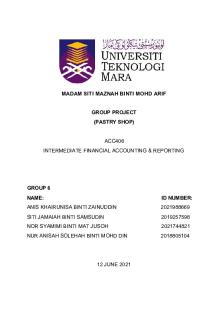
Group Project Account ( Group 6)
- 21 Pages

Art museum project
- 5 Pages

Trig art project
- 3 Pages
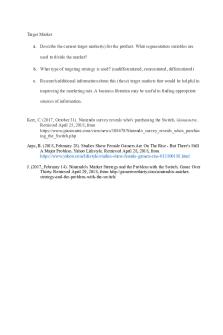
Group Project- Target Market
- 4 Pages
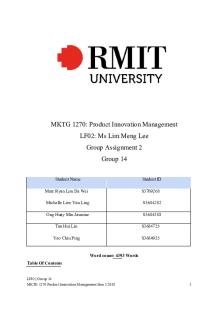
PIM Group Project 2
- 68 Pages
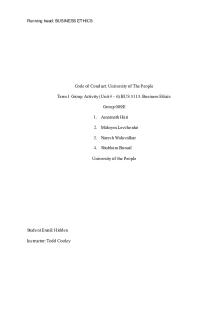
Group Project 009E Final
- 21 Pages
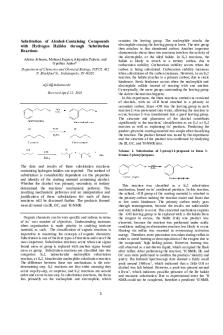
Group Project JOC Note
- 4 Pages

Group Project Proposal
- 1 Pages
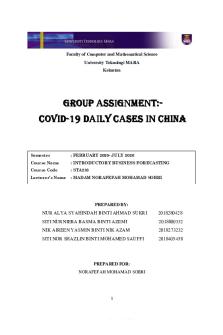
Group Project STA 233
- 33 Pages
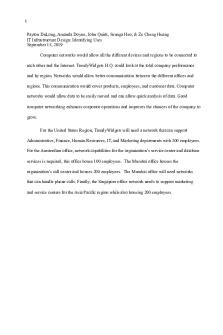
IST Group Project
- 19 Pages

Group project guidelines
- 1 Pages

group project sta108
- 55 Pages

CSR Group Project ASM401
- 18 Pages

MNT group Project
- 9 Pages

Victoria\'s Secret Group Project
- 11 Pages
Popular Institutions
- Tinajero National High School - Annex
- Politeknik Caltex Riau
- Yokohama City University
- SGT University
- University of Al-Qadisiyah
- Divine Word College of Vigan
- Techniek College Rotterdam
- Universidade de Santiago
- Universiti Teknologi MARA Cawangan Johor Kampus Pasir Gudang
- Poltekkes Kemenkes Yogyakarta
- Baguio City National High School
- Colegio san marcos
- preparatoria uno
- Centro de Bachillerato Tecnológico Industrial y de Servicios No. 107
- Dalian Maritime University
- Quang Trung Secondary School
- Colegio Tecnológico en Informática
- Corporación Regional de Educación Superior
- Grupo CEDVA
- Dar Al Uloom University
- Centro de Estudios Preuniversitarios de la Universidad Nacional de Ingeniería
- 上智大学
- Aakash International School, Nuna Majara
- San Felipe Neri Catholic School
- Kang Chiao International School - New Taipei City
- Misamis Occidental National High School
- Institución Educativa Escuela Normal Juan Ladrilleros
- Kolehiyo ng Pantukan
- Batanes State College
- Instituto Continental
- Sekolah Menengah Kejuruan Kesehatan Kaltara (Tarakan)
- Colegio de La Inmaculada Concepcion - Cebu